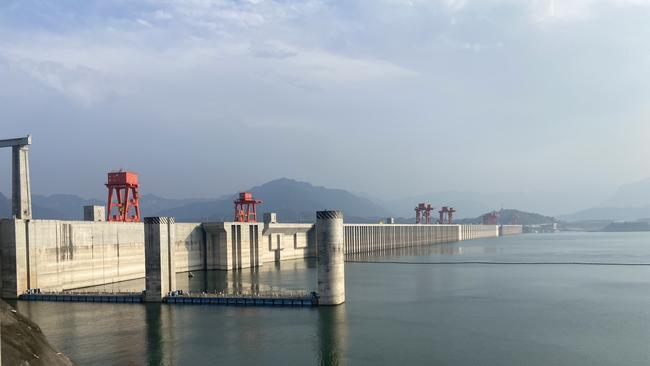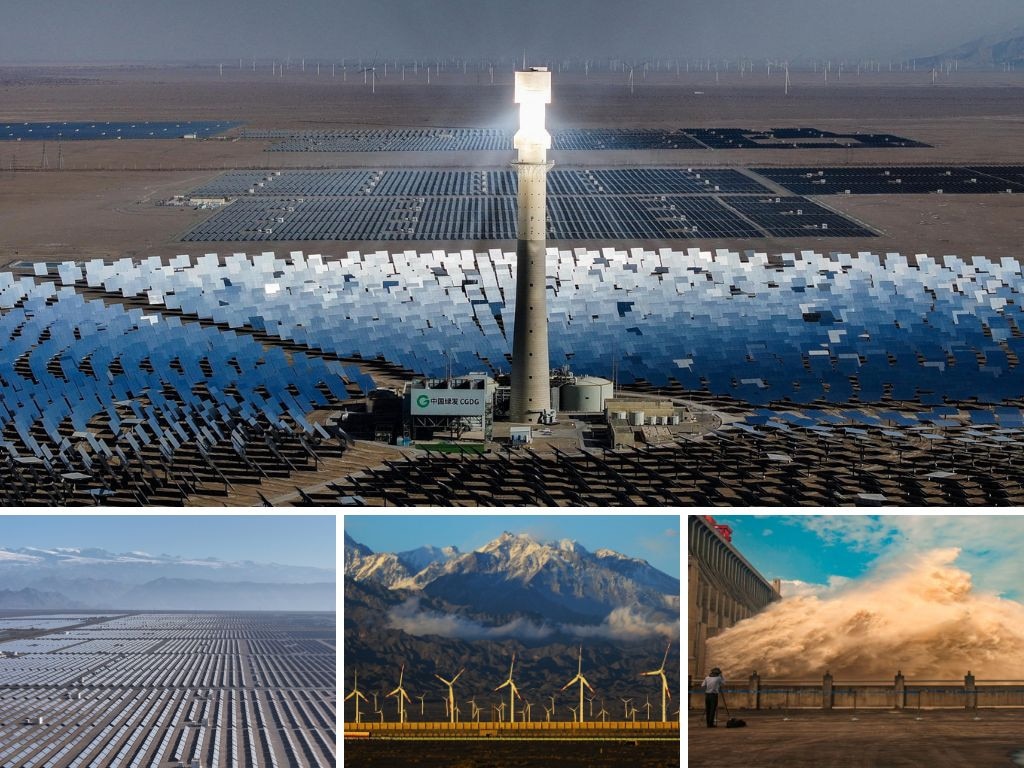China pushes on with world’s biggest dam as work stops at Australia’s Snowy Hydro 2.0
Beijing has approved a mega hydropower project in Tibet, which would generate 27 times more energy than Snowy Hydro 2.0. Unlike in Australia, industrial disputes are not expected to delay its construction schedule.
Chinese officials could be forgiven for laughing when asked about the latest strike at the Snowy Hydro 2.0 construction project.
Seen from the People’s Republic of China, a Leninist country where the local trade union movement is subservient to the ruling party, the industrial dispute at Australia’s biggest renewal project is mind-boggling.
Construction workers in China would not dare ask for “mental health” days, double time for working in the rain or a $140-a-day camp allowance – just some of demands being made by the Australian Workers Union-supported Snowy workforce, who this week downed tools once again.
Further industrial action on the $12bn Snowy project is scheduled for next week.
Pay of $200,000 a year (one million renminbi) for someone working in construction in China, the amount their Australian counterparts are pulling, is preposterous. Only the top executives at the state-owned giant Power Construction Corporation of China are paid that much.
Chinese construction workers are doing well if they are paid over $20,000 a year (100,000 renminbi) for their backbreaking work, often in punishing heat.
“China is not as lucky as Australia,” Deng Mingliang, director of the Yichang Development and Reform Committee, tells The Australian. “You don’t need to work hard in Australia,” Mr Deng says in an interview in Yichang, home of the Three Gorges Dam, the biggest hydropower project in the world.
Industrial disputes were not a problem during the construction of the Three Gorges Dam, a project so immense it was visible from the International Space Station with a rudimentary digital camera back in 2009.

Building continues
“We wanted to have the dam built as early as possible,” says Mr Deng, who moved from Tianjin to Yichang in 1996.
“Ever since construction started, building never stopped,” he says, as the sun sets on the more than the 2km-long wall of concrete that spans the Yangtze, China’s longest river.
China is not done with dams and gargantuan hydropower projects. Beijing has recently approved a mega project in Tibet, located in the lower reaches of the Yarlung Tsangpo river, which would generate three times more energy than the Three Gorges Dam – or a massive 27 times as much as Snowy 2.0.
It is scheduled for completion in 2033, a timetable China’s record suggests it will meet.
The $210bn project continues a hydropower rollout which is on a scale beyond anywhere else in the world. In 2023 alone, China’s hydropower capacity grew by 6.7GW – an amount more than three-quarters as big as Australia’s entire hydro-electric network.
It is part of Chinese President Xi Jinping’s everything, everywhere, all at once approach to electricity generation. Whatever the power source – whether hydro, nuclear, solar, wind or coal – China is building more new capacity and at a faster pace than any other nation in the world.
‘We lost our land’
The Three Gorges Dam was once a magnet of criticism in China in its relatively liberal 1980s.
That was dramatically curtailed after the publication of Chinese journalist Dai Qing’s book Yangtze! Yangtze!, which was banned in 1989, months after the deadly crackdown on the Tiananmen Square protests.
The Chinese state has encouraged amnesia about the negative effects of the project. There is no longer a single mention of the project at the Three Gorges Museum in the centre of Chongqing, one of the metropolises the Yangtze flows through.
An exhibition discussing the dam was removed. “It was controversial,” a worker at the museum told The Australian.
Construction on the Three Gorges Dam began in 1994. The project opened in 2003, although the last of its 32 generators was not fully operational until 2012.

More than 1.3 million people were relocated from the banks of the Yangtze before the river’s water level was raised by the dam.
One of them was Liu Sanmei, 60, who lives in Wanzhou, a district in Chongqing which had almost half of its old urban area permanently submerged.
“We lost our land,” the former farmer and fisherwoman tells The Australian, while working on a street corner in Wanzhou, where she now sells cigarettes.
Ms Liu speaks without bitterness, but she finds it difficult to find the words to describe the loss. “What can you do about it? It was the country’s big thing.”
There were widespread reports of local officials skimming the compensation payments that were authorised by the central government, just one of many scandals whitewashed from official accounts of the mega project.
Ms Liu says her family was told they would receive 30,000 yuan ($6400) in compensation for their forced move. “We were only given 10,000 yuan,” she says.
Source of pride
The Three Gorges Dam is now a source of great national pride. Officials boast of how it has tamed the Yangtze, stopping the deadly floods that killed millions over the thousands of years people have settled along its banks. Industrial-scale shipping from Chongqing to Wuhan to Shanghai has gone from dream to reality.
It once generated more than 10 per cent of China’s electricity, although that has fallen to around 2 per cent as the country’s electricity use has ballooned.
The mythology around the project praises China’s leaders, especially Sun Yat-sen, the first president of post-imperial China, who proposed the dam in a book in 1919 and Mao Zedong, who wrote a poem about taming the Yangtze. The project was green lit and built while two trained engineers, Jiang Zemin and then Hu Jingtao, ruled China.
Today a giant propaganda poster hangs over the site urging loyalty to China’s current leader, a common sight in the country in 2025. “Closely unite around the Party Central Committee with Comrade Xi Jinping at its core. Strive hard to win the great victory of socialism with Chinese characteristics in the new era,” the banner reads.
The original Snowy Mountains Hydro scheme is the most celebrated infrastructure project in Australia. Its diverse workforce was praised for its contribution to a nation-building project whose official death toll was 121.
A lot less fuss is made about the workforce of mostly Chinese migrant labourers who built the Three Gorges Dam. During a recent site visit, officials told The Australian they were unaware of any Chinese workers dying on the project. But Chinese news reports during the more than decade of construction record multiple deadly accidents.
In March 2002, for example, a landslide buried six migrant workers who had been pouring concrete. One worker was dug out and saved. “
The other five died on the spot,” the China News Service reported. It is likely many more deadly accidents at the site were covered up, a common occurrence in China, which has been documented by China Labor Bulletin, a Hong Kong-based NGO.
An executive at the Three Gorges Corporation said families of the five workers who died were eligible to receive about 100,000 yuan ($21,000) in compensation – less than the pay increase the Snowy 2.0 workforce is currently striking over. There is no monument, or even acknowledgment, of their deaths at the dam.
‘A better life’
Foreign journalists are not allowed access to Tibet outside of rare Chinese government-organised tours, so the construction of a mega dam will have even less scrutiny.
Chinese state media has called the Tibet dam “a safe project that prioritises ecological protection”, saying it will help Beijing achieve climate neutrality by 2060 and develop economies in the area, one of the poorest in China.
The project, which was approved by Beijing late last year, has alarmed New Delhi, which worries about what some analysts have described as its ability to give China a “chokehold” on water supplies into India.
Narendra Modi’s government has responded with a plan to build a huge dam on the Indian side of the border in Arunachal Pradesh.
Diaspora groups of Tibetans worry the giant dam will cause devastating environmental and cultural damage, just as the Three Gorges Dam did.
Thousands of cultural artefacts were submerged along the Yangtze as the Three Gorges Dam elevated water levels. The already endangered baiji, also known as the Yangtze river dolphin, was declared extinct in the years after the dam was built.
Today, Chinese officials celebrate the improvement in the Yangtze’s river quality, which they say would not have been possible without the economic development driven by cheap energy produced by the dam.
It is an exemplar of Mr Xi’s “Beautiful China” initiative, which has elevated the importance of improving the quality of China’s natural environment.
Boats now sail up and down the Yangtze, scooping up plastic bottles and other debris. A sailor on one of the government-owned cleaning boats at Wushan, a county in Chongqing near the Little Three Gorges scenic spot, says he has seen a great improvement in the water quality since he started in the job in 2008.
A Wushan county official, Captain Yu Zhihua, says the local government now spends about 6 million yuan ($1.3m) cleaning the 50km stretch of the Yangtze that falls in its city limits. The area is a popular spot for sightseeing boat rides.
Mr Yu admits there are still a few “nostalgic” locals who prefer the way the city was before the dam, but he says far more are thankful for the development.
“We have all kinds of people. Maybe one out of 100 preferred it before. They become nostalgic. But most people prefer it,” he tells The Australian, before adding: “They are living a better life.”
Additional reporting: Ewin Hannan







To join the conversation, please log in. Don't have an account? Register
Join the conversation, you are commenting as Logout